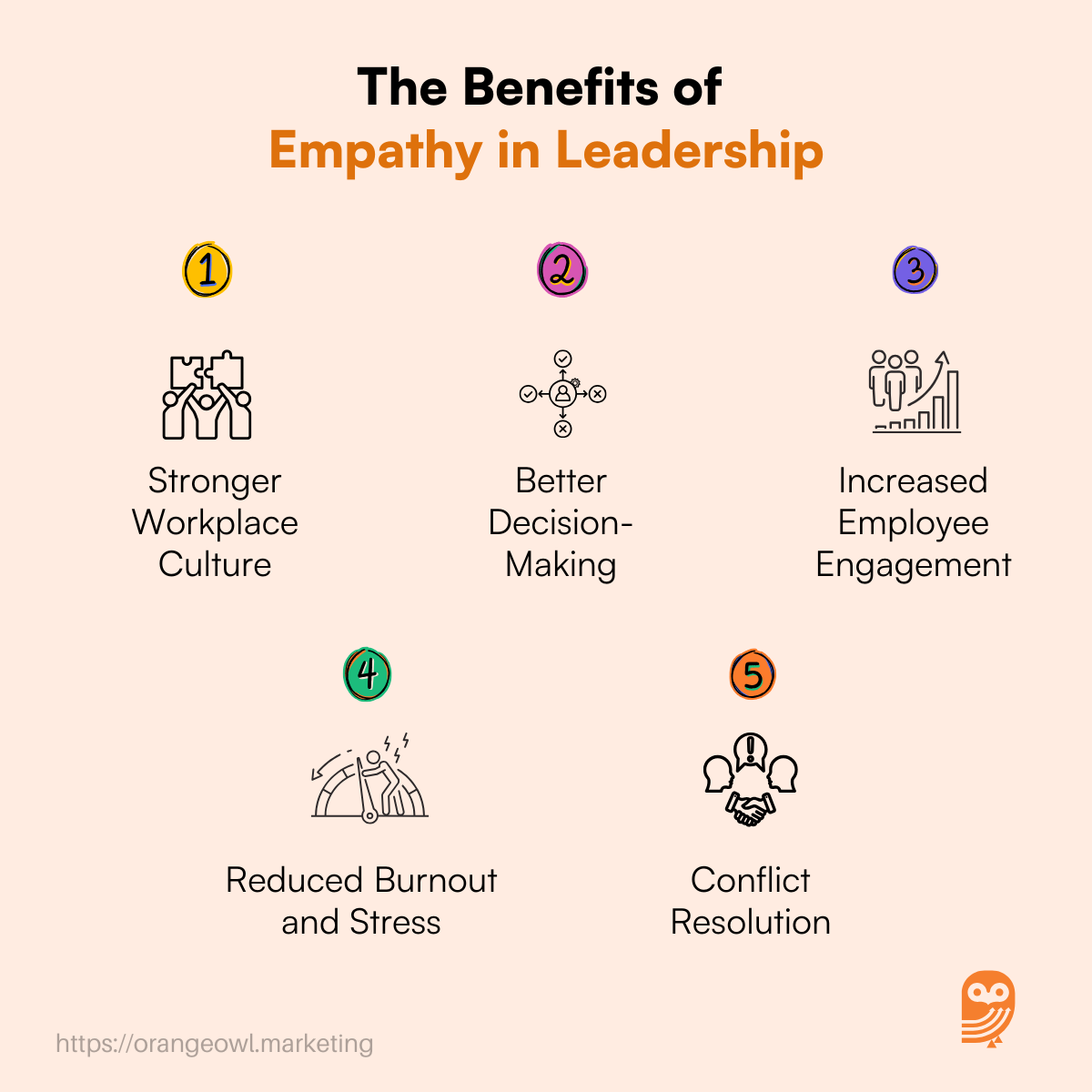In my 15+ years of leadership experience and now being the CEO at Orange Owl, I’ve found that leading with empathy has been one of the most transformative aspects of building strong, engaged teams. In this blog, I’m sharing some practical insights that have helped us create a more collaborative and supportive environment at our organization.
What is Empathetic Leadership?
Empathetic leadership is the ability to lead by putting yourself in others’ shoes, understanding their perspectives, and responding with care and thoughtfulness. It’s about creating an environment where team members feel valued, supported, and empowered to perform at their best. Empathetic leaders listen actively, address concerns genuinely, and take actions that reflect their understanding of their team’s needs and challenges.
Tech Industry: In a fast-paced software development environment, an empathetic leader might recognize signs of burnout among developers working on tight deadlines. By proactively adjusting timelines, offering support, and encouraging open communication, they foster a healthier, more productive team dynamic.
Hospitality Industry: An empathetic hotel manager may handle guest complaints not just by addressing the issue at hand but by understanding the emotional impact on the guest and ensuring they feel heard and cared for. This approach not only resolves problems but also builds loyalty and trust.
Retail Industry: A retail store manager practicing empathetic leadership might accommodate an employee’s request for a flexible schedule due to personal challenges, showing understanding and creating a supportive work environment that encourages long-term commitment.
Empathetic leadership transcends industries and situations. It’s a mindset that strengthens relationships, enhances team morale, and builds a culture of trust and openness.
The Importance of Empathy in Leadership
Empathy in leadership means putting yourself in your team’s shoes, understanding their concerns, and responding to their needs. Empathy does not equate to being soft; it’s about creating an environment where employees feel heard, valued, and respected. Leaders who practice empathy foster:
Trust: Employees trust leaders who genuinely care about their well-being, leading to higher morale and productivity.
Collaboration: Empathy promotes open communication and breaks down barriers, leading to better teamwork and problem-solving.
Employee Well-being: Understanding the personal and professional challenges employees face helps leaders provide the necessary support, reducing burnout and improving work satisfaction.
Increased Retention: Employees stay longer in organizations where they feel understood and supported by their leaders.
Innovation and Creativity: Empathy encourages a culture where employees feel safe to take risks, which leads to creative solutions and innovation.
Higher Performance: When employees feel emotionally supported, they are more motivated and productive.
The Benefits of Empathy in Leadership
Stronger Workplace Culture: Empathy helps build a workplace culture that is people-centered. Employees who feel understood and supported are more engaged, motivated, and willing to go the extra mile for their teams and organizations.
Better Decision-Making: Empathetic leaders can consider different viewpoints, leading to more informed and thoughtful decision-making. This leads to solutions that better align with the needs of both the organization and the employees.
Increased Employee Engagement: When employees feel valued and understood, they are more likely to engage with their work, leading to increased productivity and job satisfaction.
Reduced Burnout and Stress: Leaders who prioritize empathy are attuned to the well-being of their employees. By addressing their team members’ emotional and mental needs, they can help reduce stress and prevent burnout.
Conflict Resolution: Empathetic leaders are better equipped to navigate conflicts by understanding the emotions behind disagreements and helping individuals reach mutually beneficial solutions.

Creating an Empathetic Environment: Step-by-Step Guide
Empathy in the workplace doesn’t happen overnight. It requires continuous effort and intentional actions from leadership. Below are practical steps to foster empathy in your organization, along with hypothetical scenarios that demonstrate how they can be applied.
1. Lead by Example
Leaders must model empathetic behavior. Be open about your challenges, show understanding of your team’s difficulties, and offer support. When leaders demonstrate empathy, employees are more likely to follow suit.
Hypothetical Scenario:
Sarah, the CEO of a tech startup, notices her team is feeling overwhelmed by a project deadline. Instead of just encouraging them to push through, she acknowledges their stress and personally steps in to help with some tasks. She also shares her own strategies for managing stress in team meetings and invites others to do the same. Her actions signal that it’s okay to talk about challenges, and the team feels more comfortable discussing their own struggles.
2. Encourage Open Communication
Create safe spaces for employees to communicate openly. Regular one-on-one meetings, anonymous surveys, and feedback forums can encourage employees to express their thoughts without fear of judgment.
Hypothetical Scenario:
John, a marketing manager, realizes that team members are hesitant to share concerns during meetings. He sets up “office hours” where employees can drop in to discuss any issue, and introduces an anonymous feedback system. Over time, the team starts speaking more openly, sharing ideas, and raising concerns that were previously overlooked.
3. Promote Emotional Intelligence (EQ)
Provide emotional intelligence training to help employees and leaders better understand their own emotions and those of others. EQ is a key driver of empathy and effective collaboration.
Hypothetical Scenario:
Rachel, the HR Director, notices that employees often react emotionally to work stress, leading to conflicts. She organizes workshops on emotional intelligence, teaching employees to better manage their emotions and understand those of others. As a result, teams work more harmoniously and conflicts are resolved more constructively.
4. Practice Active Listening
Active listening involves fully concentrating on what the speaker is saying, asking clarifying questions, and responding thoughtfully. This practice shows that you genuinely care about others’ perspectives.
Hypothetical Scenario:
Alex, a team leader in a software company, realizes that some team members feel unheard during project discussions. He starts practicing active listening, asking open-ended questions and paraphrasing what he hears. During meetings, Alex asks team members how they feel about challenges and seeks their input before making decisions. This makes employees feel more valued and engaged.
5. Recognize and Address Employee Concerns
Address employee concerns promptly and with care. When employees feel their issues are taken seriously, they are more likely to trust leadership and stay engaged.
Hypothetical Scenario:
Linda, a sales director, hears that her team is unhappy with a new commission structure. Instead of dismissing their concerns, she schedules a meeting to listen. Based on their feedback, she makes adjustments to ensure fairness and communicates the rationale behind the changes. Her team feels respected and supported, and morale improves.
6. Support Work-Life Balance
Encourage work-life balance by offering flexible schedules, remote work options, or wellness programs. Regularly check in with employees to ensure they are not feeling overwhelmed.
Hypothetical Scenario:
David, a manager in a consulting firm, realizes his team is working late nights and weekends due to tight deadlines. He introduces flexible work hours and “no meeting Fridays” to help employees manage their workload and personal life better. He also regularly checks in to make sure no one is feeling burned out. As a result, the team feels more supported and experiences less stress.
7. Create Psychological Safety
Create a work environment where employees feel safe to express ideas and admit mistakes without fear of negative consequences. This encourages creativity and collaboration.
Hypothetical Scenario:
Nina, a product manager, notices her team is hesitant to share bold ideas during brainstorming sessions. She explicitly states that all ideas are welcome and ensures that feedback is constructive. Over time, team members start suggesting more creative solutions without fear of judgment, leading to innovative projects.
8. Empower Middle Management
Train middle managers in empathetic leadership and provide them with the resources they need to support their teams effectively. Empower them to be role models of empathy within the organization.
Hypothetical Scenario:
Michael, the CEO of a logistics company, sees that middle managers struggle to apply empathy while meeting targets. He sets up leadership development programs that teach emotional intelligence and team-building skills, while also providing mentorship. As middle managers grow in their ability to lead empathetically, team morale and performance improve.
9. Celebrate Empathy
Publicly recognize and reward empathetic behavior within your team. Celebrating these moments reinforces empathy as a core value in the organization.
Hypothetical Scenario:
At a healthcare company, Jenna, the head of HR, sets up a monthly “Empathy Award,” recognizing employees who go above and beyond in supporting their colleagues. This might be helping someone through a personal crisis or assisting with heavy workloads. These moments are celebrated during company meetings, encouraging others to follow suit.
10. Measure and Improve
Use feedback tools and surveys to measure the impact of empathetic leadership. Regularly assess and adjust your approach based on the data to continuously improve.
Hypothetical Scenario:
Tom, the COO of a software company, wants to ensure empathy is embedded in the company culture. He introduces quarterly employee surveys to measure how supported employees feel. Based on the results, he implements improvements like additional training for managers and revising workload distribution. Over time, survey results show increased employee satisfaction.
Actionable To-Do List for Leaders and Organizations
Conduct an Empathy Audit: Assess the current level of empathy in your leadership and organization through surveys and feedback.
Provide Training: Offer emotional intelligence workshops to help leaders and employees develop empathy and better communication skills.
Set Empathy Goals: Include empathy in performance reviews and leadership assessments to ensure it’s prioritized.
Foster Feedback Culture: Encourage regular feedback and make changes based on what you hear from employees.
Develop Wellness Programs: Promote work-life balance through flexible working hours, mental health support, and wellness initiatives.
Create Peer Support Groups: Encourage the creation of support groups where employees can discuss their challenges in a non-judgmental environment.
Celebrate Empathy in Action: Recognize empathetic behavior publicly to set an example and encourage others to follow.
Best Practices and Pro Tips for Empathy in Leadership
Pro Tip #1: Ask Before You Assume: Don’t jump to conclusions about how someone is feeling or what they need. Ask questions, and let them share their perspective.
Pro Tip #2: Give Undivided Attention: When speaking with employees, be present. Put away distractions and focus on the conversation at hand to show that you value their input.
Pro Tip #3: Make Time for Empathy: Empathy takes time, but it’s worth the investment. Set aside time for regular check-ins with your team members and get to know them on a personal level.
Pro Tip #4: Don’t Confuse Empathy with Weakness: Empathy doesn’t mean letting poor performance slide. You can be empathetic and still hold employees accountable, as long as you’re addressing their concerns in a constructive way.
Pro Tip #5: Lead with Vulnerability: Show your human side. Leaders who share their own challenges and vulnerabilities build deeper connections with their teams.
Conclusion
Empathy in leadership is not just a “nice to have”; it’s essential for creating a positive, productive work environment. By fostering empathy, leaders can build stronger, more engaged teams, reduce burnout, and improve overall performance.
The steps outlined in this blog provide a roadmap for leaders and organizations looking to embed empathy into their culture, with real-world scenarios that show how these principles can be applied practically. By embracing empathy, you create a foundation for a more compassionate, successful organization.



